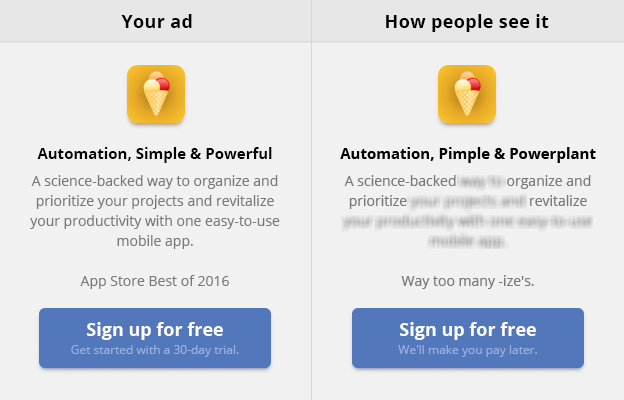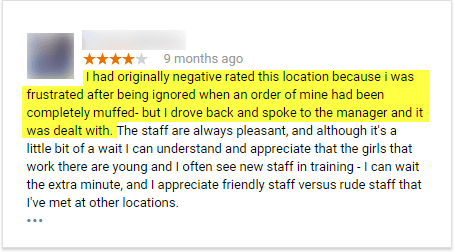Social selling, or the real power of the Whispering Lady

So here you are. Sitting in your office chair scrutinizing over whether you should order that ad campaign from that industry resource (their Alexa looks good, but that doesn’t give them the right to charge 3 grand for a single post!), or bid on that high CPC keyword in AdWords (yikes, 20 bucks per click, are you serious?), or…
There’s no such thing as ‘just enough traffic’, right? You always want more. Because more traffic means more signups, and more signups means more sales.
You know just what that ad will do. It’ll land a few hundred people on your site. They’ll check out what you’re offering, and some 90% of them will leave and go on with their lives. Or, if your campaign is well-targeted and you hired a good copywriter for your CTAs, you could even lower that to 85%. That wouldn’t justify the cost of your ad, but you’ll write it off as something you can’t measure – you got exposure, right? At least those 85% now know about you. Maybe they’ll come back later. Maybe you’ll retarget like mad and they’ll eventually convert.
Those 85% just don’t seem to be interested (why on earth did they click on my ad in the first place?), but you can’t impact that. So, after a moment of hesitation, you go and finish the ad transaction (maybe this one will do OK).
But hang on, let’s roll back one sentence.
You can’t impact that.
For a moment, I’d like you to question that thought. Better yet, forget that thought altogether, stop there, and chill. I’ll only take 10 minutes of your time. That ad campaign won’t go anywhere, promise.
First, let me make one thing clear: I’m not going to tell you advertising is dead or ineffective. I’m not going to tell you about aquisition funnels, either: I’m not too crazy about funnels; we don’t get a lot of them in the physical world, so it’s a tough metaphor to relate to. How about stairs?
Let’s settle on this: advertising is an incredibly powerful step on the acquisition staircase. What I’m going to argue though is that it’s just that – a step. It’s not a channel of its own like it used to be. There are many other steps, and people will inevitably keep stumbling and falling down (or deciding against climbing the stairs altogether) unless you take care of the entire staircase.

Your customers are no Lara Crofts.
The customer is not a moron. She is you.
Now that we’re clear on this, let me ask you for a favor. I want you to imagine that you're the one about to climb that staircase, not the one waiting upstairs. Sit back and remember last time you ordered a non-physical product or service online from an unfamiliar provider. I want you to actually remember it. Maybe it was some kind of an analytics platform for your website, a hosting service, or cloud storage for all your files. A productivity app for your smartphone. Anything.
Now, I want you to remember how you ended up buying from that company. Did you see an ad some place and go all ‘hmmm, that ad looks gorge, their call to action is staggeringly well put, let me get my credit card?’
Or, perhaps, you went ‘I’ll Google that thing and see how they’re better than other options. I’ll read some effing reviews on G2Crowd or AppStore from some real people. I’ll see what their users are saying on social. And if I’m not convinced, I’ll start a bloody Quora thread.’
Which one?
What I’m driving at is that increasingly on the Internet, real people determine the fate of products. Building a successful product requires getting to know these people, making friends with them, and at times, even being those people (I’ll get to that in a moment).
Ads, like many other marketing and sales activities, can also be important steps. Those can be found both at the top and the bottom of your staircase; and their job is to either inform people about your product (so that they'll know its name and what it does, even subconsciously), or reinforce what they already know about your product, give them a little reminder, a tiny extra push, so that they finally give it a try.
If you rely on advertising too heavily though, you will inevitably fail. First, there’s simply too much of advertising. In the Internet of pop-ups, display network ads, banners and calls-to-action, the impact an ad could have had 20 years ago has boiled down to a fraction of that at best. Second, when there are other sources of information that consumers justly find more believable than your company’s marketing materials, well… They’re gonna turn to those sources. If you think that’s an exaggeration, next time you see and ad online, take careful note of your own reaction to it. 
The Whispering Lady
If I can get you into another simple thought experiment, here’s one. For scientific purposes, imagine you have dandruff (I’m sorry if that’s a sensitive topic). You’ve never had it before, and now it’s suddenly here. It bothers you. You’ve tried a few anti-dandruff shampoos you found at a local supermarket, but they either didn’t work or left your hair greasy.
So you’re strolling the aisles of your local supermarket and go to the shampoo shelf looking to try some other brand, not too hopeful. By that shelf, you see two women. Quietly, one of them says to the other:
“You have no idea.”
You’re standing there, drilling the shelf with your eyes, feeling life isn’t worth living.
“You know how I’ve been struggling with dandruff for years. Nothing. Ever. Helped.”
You raise your eyes and examine the lady’s hair for any traces of dandruff.
You find none.
“All the shampoos I tried either didn’t work or left my hair greasy as hell.”
As the lady speaks, her voice keeps trailing off until she turns it down to a whisper, like she’s about to share the universe’s best kept secret. Inconspicuously, inch by inch, you move closer to the whispering lady so you can make out the secret as her voice drops.
“And then they came up with this one,” – she points subtly at one of the bottles on the shelf. “It’s crazy. I washed my hair with it twice and got rid of the problem. You have to use it for life, of course, but why wouldn’t you? It works. It smells great, and my hair is soft and shiny after I use it.”
At that moment, I swear, life suddenly makes sense again, and you’re sweeping all those miracles from the shelves and rushing to the shop assistant asking if they have more. Content, you leave the supermarket with a lifetime supply of those bottles of joy.
End of scene.
What’s in it for me, anyway?
Chances are you don’t sell physical goods in a local supermarket. Even if you do, sending in a whispering lady to each one of those would be costly and suspicious. But that doesn't mean you can't do social selling. Here’re some fun statistics:
- For in-store purchases, 81% of consumers research their options online before going to a store. (Source)
- For online purchases, 94% of shoppers conduct research on the Internet before they make a purchase.
- Only 7% of businesses knowingly utilize social selling. (Source) That gives you the chance to be the first to utilize it among your competitors – the chance that is slowly decreasing as you’re reading these words. And even when your competitors follow through (believe me, at some point they will), you’ll already be miles ahead and have an army of whispering ladies on your side.
- Social selling is as effective for B2B as it is for B2C. Thanks to their social selling program, IBM increased sales by 400%. (Source)
All of that makes perfect sense: the Internet is where you can find thousands of whispering ladies, if you will just look. In fact, you know the exact places they hang out. G2Crowd for web apps. Yelp and TripAdvisor for restaurants. Blogs and industry forums. Social media for EVERYTHING.
The bad news is, if you aren’t there, chances are that ad campaign you’re scrutinizing over will be a miserable failure. There’s a whispering lady in every niche and industry, and trust me, she knows her business.
The good news? You can find, get to know, and nurture those whispering ladies. In fact… Let me whisper this: You can be one yourself. Now that we figured out you have no time to lose, let’s get down to the actionable bit and apply all of this to your business.
Ok, ok, but how?
1. Listen carefully.
Web and social media monitoring is the very first thing you should do if you’re looking to make use of social media selling. It comes before the compulsive social media management and even before having a Facebook page. It’s the critical first step.
“At the rep level, social media is less about tweeting than it is about listening, reading and knowing what people are talking about. That's what lets them better tailor their contributions to the discussion."Douglas Hannan, Inside Sales Marketing Executive, IBM
But what should you monitor the Web for? First and foremost, mentions of your own brand, product, and company. Second, industry keywords and your competitors. There are tools designed specifically for social media monitoring like our own Awario (you can sign up for a free trial here; it takes one field - your email address - and about 0.2 seconds to get started). Try creating separate alerts for your brand-related keywords (brand name, products, etc), competitors (their brand and products), and industry terms (your product category, things your product does, problems it solves).
Which platforms should you monitor? Ideally, all the major ones; over time, you will definitely see which are the most active in your niche, and divide the time you spend on each accordingly. However, never make the mistake of discarding a platform completely - even if YouTube seems irrelevant to your business, you will definitely want to know if someone posts a raging video review of your product.
2. Step in, in an appropriate and timely manner.
Appropriate reaction from an appropriate person, as well as timing, are critical to social selling success. Sometimes, you'll need to reply within minutes; sometimes, you'll have to go into mute mode and silently digest the information you find. Often, you’ll represent exactly who you are – a company rep interacting with a customer; every now and then, you'll have to be a whispering lady of sorts. For every business and product niche, you’re going to come across various kinds of mentions, and you'll need an appropriate pattern to deal with each. Here are some of the most common types you'll almost surely find.
- Positive reviews.
Good reviews of your product or company can be posted on personal blogs, forums, social networks, review sites, etc. They don't have to be reviews in the strict sense - any kind of positive feedback qualifies. Usually, your response pattern here would be to thank the reviewer, and ideally, start building a relationship with them (by engaging with their posts, for example). A whispering lady is being born there, and you don't want to leave that unnoticed.
You'll want to reply from your brand's official account, or your own account as long as it is straightforward that you work for the company.
- Negative reviews.
These will inevitably happen. Negative feedback is often hard to deal with, but, again, you can't pretend it doesn't exist. Acknowledging and dealing with it has many benefits beyond direct social selling: first, it offers insights into the problems your customers are experiencing, so you can prioritize your activities and resolve them. Second, reacting to them reasonably and, if necessary, offering an apology, will get you credit for being human and can, at least in part, impact the opinion of the unhappy reviewer and everyone reading. Third, you can even make this happen: 
Source: searchenginepeople.com
Again, typically you'll want to reply from your brand's account, or your own account indicating that you work for the company.
- Product-related problems and questions.
These will come from your customers who've stumbled upon a difficulty in using your product or service. Ignoring these questions is plain stupid, as you might end up losing some of the customers you already have and worked hard to get. If you're wondering why on earth they are tweeting their questions into the world instead of just calling you, you're forgetting something important: social media is the place for EVERYTHING. And, well, a call is a bigger undertaking than a tweet.
Twitter users are especially demanding: over 70% of tweeters expect to hear back from the brand they’re mentioning, and 53% want a response within one hour.
Again, ideally, you should respond from either your brand's or your own account (if it's the latter, make sure you introduce yourself and make your position at the company clear).
- Influencer acknowledgements.
These whispering ladies have a mike in hand and a crowd of people in front of them. While they're passionately telling that crowd about your product, you don't want to be having lunch around the corner, totally unaware of the show (or, worse, still scrutinizing over that ad). Instead, you might want to come over, listen, and make friends with those influencers. They already love your product, so believe me, they wouldn't mind.
In Awario, you can identify the most influential mentions by Reach - this is the size of each influencer's crowd, or the number of people that potentially see the post.
- Niche-related discussions.
This is a huge group. You've got to look for people discussing your industry, and places where these discussions typically happen (think forum threads and social media communities). Unlike the previous kinds, these mentions seldom need your immediate response. Instead, you've got to figure out the most influential communities, and do all you can to become one of their active members. Of course, you'll want to make meaningful contributions (after all, your industry is also your area of expertise, right?) rather than any straightforward selling or marketing. Often, it's best to not even mention the product before you become an authoritative contributor. But when you finally are one... you get the permission to spread the word about your product (please be gentle) along with dozens of influential friends and connections you wouldn't have made otherwise - other contributors who don't know about your product or aren't its avid supporters. These are the best whispering ladies you can get.
For obvious reasons, posting from a company account won't do here; you'll want to post from your personal account or even on behalf of someone else - somewhat deservedly, many such communities hate marketers.
- Research-stage questions.
This category is also vast. Research-stage questions will often happen on forums, communities, and Q&A sites. Look for people researching a product like yours or asking for advice in evaluating available options. Often, users won't even know they're in the research phase - they may be simply complaining about a problem you can solve without knowingly seeking a solution. So do invest some time in choosing the right keywords to monitor.
Mostly, you'll want to act as a person - more often a fictional whispering lady than your own self - rather than a brand/company (remember the supermarket lady and the anti-dandruff shampoo: "you have no idea..."). Sometimes though, e.g., when someone is explicitly complaining about a problem your product can solve, it's perfectly legit to respond from your business account and be pretty straightforward about who you are, what you offer and how it can help. They got a problem, you got a solution.
- Positive reviews (competitors).
Like all other reviews, these happen on blogs, forums, social media, review sites, and so on. The difference is that in most cases, these reviews don't call for your reply. Instead, they're sources of competitive intelligence. Positive feedback about your competitors will help you figure out what it is about them that their customers like best (so you can improve your own product) and who their most active supporters are (so you can watch them and, when you get a chance, start building relationships with them).
- Negative reviews (competitors).
I hope you're excited, because these are a goldmine! These are often written by warm leads who'll be happy to switch to a better option as long as you make the switching easy and clearly worth it.
Sometimes, you'll be able to act as your brand or a rep; more often, you'll need to be a whispering lady. Turn on your inner psychologist to decide which will work better in each case.
- Influencer acknowledgements (competitors).
These acknowledgements are not necessarily positive reviews, although they can be. Typically, they are mentions of competitors' products, often found in blog posts. Depending on how well-known and authoritative the influencer is, your response pattern could be different. With some experts, you may want to reach out and tell them about your product right away, acting as your own self and telling them where you stand in the company. For celebrity-level ones, you might need to start monitoring them closely, engaging with their content, and building that relationship that will give you a chance to use their whispering powers to your own advantage.
3. Analyze.
As you monitor and react to all those types of mentions above, you'll quickly see that you need to run an analysis of those mentions and your own activities from time to time. A single influential post about your product can be a big deal, but think about it: if an influencer mentioned your competitor once, and then completely forgot about them, that influencer is often not worth chasing after (even though that post's Reach was insane). Similarly, twenty mentions by someone who isn't necessarily an influencer, combined, may have the same Reach as that single mention.
Or, when you've interacted with a few dozen people, you'll find yourself wondering, "Have I talked to that person already? Have I seen them somewhere? Have they said something about our company or competitors before?".
Lastly, of course, you need to track the progress you make and compare the results each relationship/platform/activity yields.
To figure all of that out and ensure that your efforts are evenly distributed and rightfully prioritized, you need analytics. In some of the social monitoring apps, you'll find them in a separate dashboard. Awario's Mention Statistics, for example, gives you a breakdown of the progress in mentions you make across any time period and compared to any other, and even lets you compare influencers across each social network with top active authors (the ones that frequently mention your keywords).

And (psst!) we've got a bunch of features coming in two weeks, all intended to help you analyze and organize your activities and relationships with influencers. Namely, you'll be able to see the entire history of your interactions with the author for every mention you're about to respond to, and build up reports on those activities and conversations to analyze their effectiveness.
One last thing
There are dozens of classifications, patterns, strategies, 5-step guides, and entire volumes on social media marketing you'll never have the time (or need) to go through. And then, there's one simple thing remembering which will help you make all the tough decisions throughout your social selling campaigns:
Increasingly, explicit marketing is being complemented by implicit marketing; and one whispering lady is worth a dozen banners. Whenever you're in doubt about what's the right way to interact with a prospecton social media, remember the lady from the supermarket. How she'll turn her voice down instead of screaming her affection for the product out loud. How she is on the same side of the fence, not the opposite. How she knows exactly how it feels. How she has no interest in having your money.
And boy is she more believable than your ad.













